Kites in Japan: Flying Through History and Heart
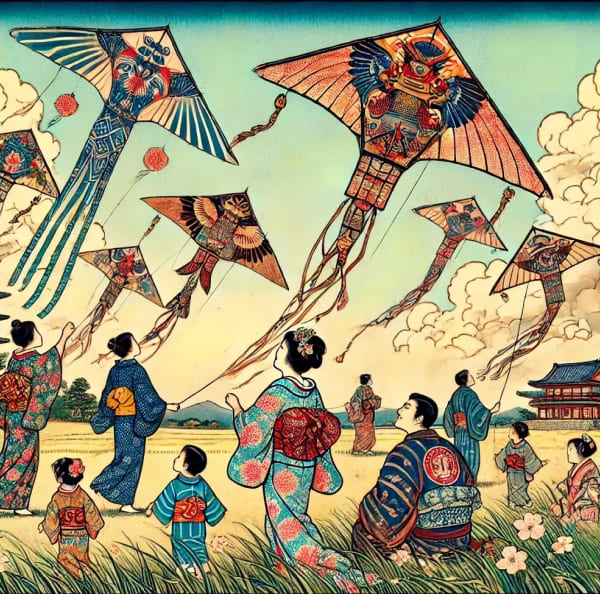
Contents
Imagine a sky filled with vibrant, colorful kites — each one carrying smiles, wishes, and a little piece of joy.
For centuries, kite flying in Japan has been more than a game — it’s a celebration of hope and togetherness, passed down from generation to generation.
How did Japan’s kite culture take shape through history?
And why do these graceful creations continue to capture hearts in the modern world?
Let’s take a journey through the skies of Japan — to discover the stories, artistry, and heartfelt spirit behind one of the nation’s most joyful traditions.
What Is a Japanese Kite?
Before we journey into history, let’s take a moment to understand what makes a Japanese kite so special.
Kites can be found all around the world, but in Japan, they are far more than toys that dance in the wind.
They are symbols of joy, celebration, and heartfelt prayers.
Each kite is lovingly handmade — its frame crafted from wood or bamboo, and its surface made of washi paper or cloth.
When the wind lifts it high into the sky, the kite seems to come alive — graceful, vibrant, and full of spirit, like a messenger linking heaven and earth.

Some are boldly painted with samurai or mythical creatures, while others carry simple yet sincere wishes — for a child’s good health, a family’s happiness, or the coming of good fortune.
Every brushstroke and knot of string reflects quiet devotion to beauty and tradition.
These creations, known as wadako (和凧), are not merely crafts; they are living expressions of Japanese artistry and celebration — where the wind itself becomes a bridge connecting people, nature, and hope.
From Aristocratic Pastime to Popular Tradition: The Evolution of Kites in Japan
So how did Japan’s kites first take flight, and how have they evolved through the ages?
Let’s trace their story through time — from elegant courtly pastimes to the vibrant celebrations that still color Japan’s skies today.
Early References and Aristocratic Enjoyment
The very first kites to grace Japan’s skies are said to have drifted gently above the gardens of ancient nobles.
Introduced from China sometime before the Heian period (794–1185), kites soon became a graceful pastime among the aristocrats of the imperial court.
The oldest written record appears in the Wamyō Ruijushō (和名類聚抄), a 10th-century Japanese dictionary, where kites are described as shiroushi (紙老鳶) or shien (紙鳶) — literally meaning “paper hawks” that fluttered elegantly in the wind.
Using delicate bamboo frames covered with washi paper, the nobles crafted beautiful shapes: the square kaku-dako, the hexagonal rokkaku-dako, and the charming yakko-dako — a figure with outstretched arms.
In those refined days, kites were more than mere playthings.
They floated as symbols of beauty, grace, and poetic imagination — delicate creations that captured the elegance of the Heian age itself.
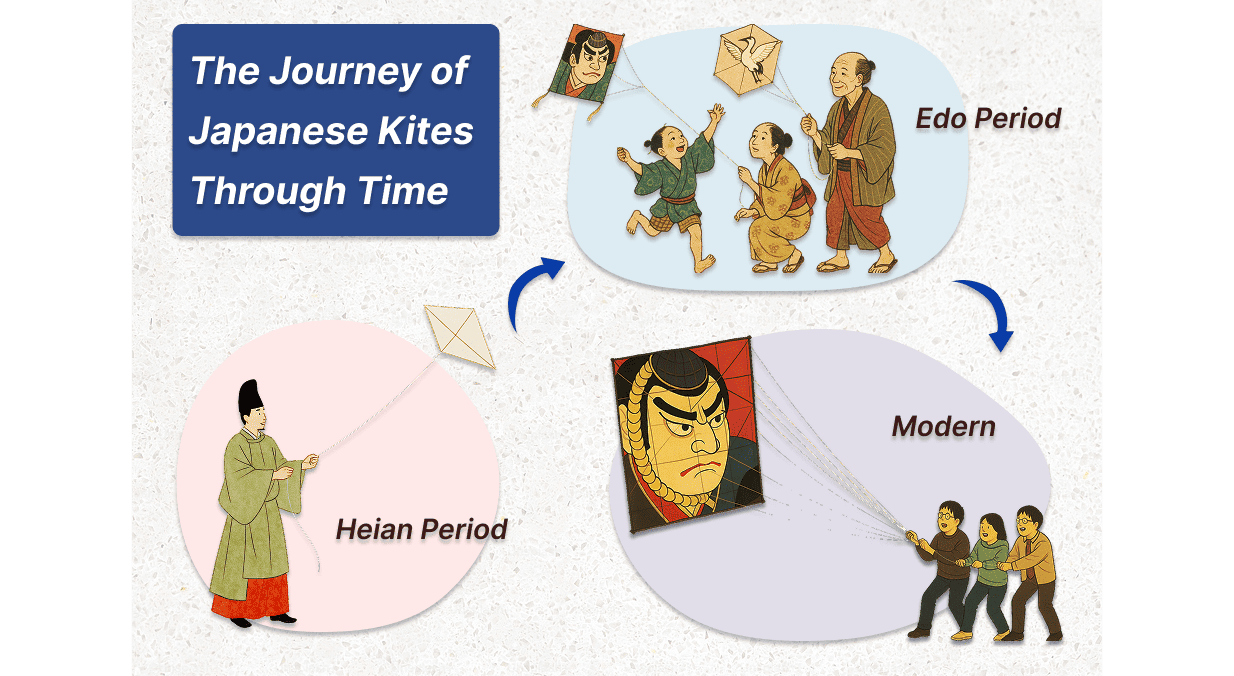
International Influence: New Winds in Nagasaki
In the 17th century, new winds of inspiration arrived in Japan through the busy port of Nagasaki.
Trading ships brought with them diamond-shaped kites — designs that had traveled across the seas from Southeast Asia and the Middle East.
It is said that foreign residents, including Indonesian workers employed by Dutch merchants, introduced these distinctive kites to Japan.
The local people, fascinated by their bright colors and fluttering shapes, began calling them “Hata” (旗) — meaning “flag,” after the colorful banners that waved proudly from the masts of foreign ships.
Through this meeting of cultures, a new regional kite style was born — a graceful blend of foreign influence and Japanese artistry.
The Edo Period: When the Sky Belonged to Everyone
During the Edo period (1603–1868), kite flying spread far beyond the courts and noble estates, reaching everyday people.
Merchants, farmers, and children alike filled the skies with bold, brightly painted kites that danced joyfully in the wind.
Kite flying became part of daily life — a cheerful pastime across Japan.
In some towns, this simple pleasure grew into lively competitions.
Kite fighting, a thrilling contest where fliers tried to cut their opponents’ strings with glass-coated lines, became incredibly popular.
Hundreds of kites filled the sky, weaving, colliding, and spinning.
Crowds gathered in open fields and town squares, cheering as kites soared, tangled, and clashed in midair.
Modern Times: From Daily Fun to Seasonal Celebration
As Japan entered the Meiji period (1868–1912), the nation began to change rapidly.
New technologies, power lines, and growing cities made kite flying in urban areas increasingly difficult — and sometimes even dangerous.
In some regions, local laws were introduced to restrict kite flying to prevent accidents and power outages.
Yet, the tradition never disappeared.
Instead, kite flying transformed into a seasonal delight, enjoyed especially during New Year’s and children’s festivals.
What had once been a common sight in everyday life became a joyful holiday activity, shared by families and communities alike.
Families gathered and sent their colorful kites soaring high — each one carrying prayers for happiness, health, and good fortune.
From the graceful pastimes of ancient nobles to the lively festivals of today, the history of Japan’s kites is a story of transformation — a journey through time and tradition.
With every gust of wind, they carry beauty, creativity, and the spirit of community high into the sky.
The Changing Names of Kites in Japan
In Japanese, kites are called “tako” (凧) — but just like the kites themselves, this name has changed and evolved over time.
In this section, let’s take a closer look at how the names of Japanese kites have transformed through history.
Words That Fly: The Many Names of Japanese Kites
Interestingly, Japanese kites were not always called “tako” (凧) throughout the country.
The diversity of kite names reflects Japan’s culture, creativity, and historical events that shaped everyday life.
Several factors influenced how these names came to be — the following were particularly influential:
- Regional dialects and cultural traditions
- The shape and movement of each kite
- Historical events — such as the kite-flying bans of the Edo period
- Foreign influences from lively port towns like Nagasaki
Together, these elements intertwined to create a colorful variety of names — each one a small reflection of Japan’s regional character and its rich, ever-changing history.
How ‘Ika’ Became ‘Tako’: The Edo Period Wordplay
One of the most memorable moments in the history of kite names took place during the Edo period (1603–1868).
In the bustling city of Edo (modern-day Tokyo), kite flying became wildly popular among townspeople.
But at that time, the people of Edo called their kites “ika-nobori” (いかのぼり) — meaning “squid climbing.”
The name came from the kite’s long flowing tails, which looked like a squid’s tentacles waving in the wind.
As kites grew larger and more elaborate, accidents began to happen more often.
Eventually, in 1655, the Tokugawa shogunate issued a strict ban:
町中にてイカノボリを揚げる事を禁ず
No kite flying in the towns.
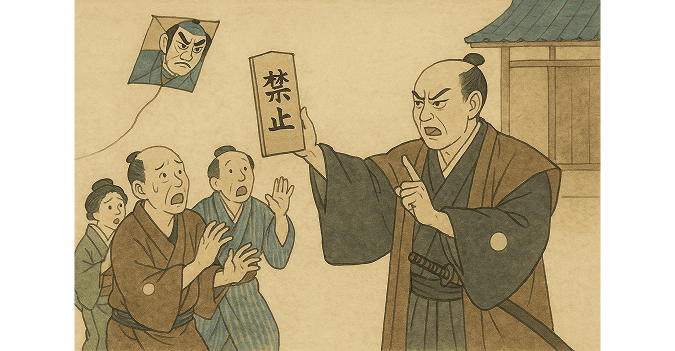
The clever and playful people of Edo, however, found a simple way to get around the law.
They just changed the name — from “ika” (squid) to “tako” (octopus).
It was the same joy, the same sky, but under a new name.
And so, “tako” was born — a small act of linguistic mischief that helped the tradition continue to soar.
Over time, “tako” became the standard name in Eastern Japan, and it remains the word we use today — a lasting reminder of Edo’s wit, humor, and love for kite flying.
Kite Names Across Japan: A Patchwork of Local Voices
Many regions have preserved their own unique local names, each reflecting the character and traditions of its area.
Let’s take a look at some of the representative regional names for kites throughout Japan.

| Region | Common Name | Meaning / Notes |
|---|---|---|
| Kanto (including Edo/Tokyo), Tohoku (Japan Sea side), Tokai | Tako (凧) | “Octopus” — adopted after the Edo ban |
| Kansai, Hokuriku, Chugoku, Shikoku (parts) | Ika / Ikanobori (烏賊) | “Squid” — reflects kite’s tail shape |
| Nagasaki, Kyushu (northwest) | Hata (旗) | “Flag” — influenced by foreign traders |
| Hiroshima, Yamaguchi | Yozu | Local dialect term |
| Seto Inland Sea (Awaji Island, etc.) | Yōkanbē | Local dialect term |
| Miyazaki (Nichinan area) | Kamome | “Seagull” — likely inspired by its shape |
What do you think when you hear these names — tako, ika, hata, kamome?
Each one evokes images of the sky or sea, gracefully moving with the wind.
Through these names, Japan’s kite culture reveals not only its visual creativity, but also the deep richness of language and imagination woven into its traditions.
Traditional Types of Japanese Kites
Now that we’ve explored the history and changing names of Japanese kites, let’s take a closer look together at the different types of traditional kites found across Japan.
What kinds of shapes, styles, and unique features have made them so special throughout the centuries?
Common Materials
Let’s begin by looking at the materials and craftsmanship behind Japan’s traditional kites, known as wadako (和凧).
These kites are handcrafted with natural materials — a process that reflects both skill and respect for nature.
Each part is chosen not only for function, but also for beauty, balance, and harmony with the wind.
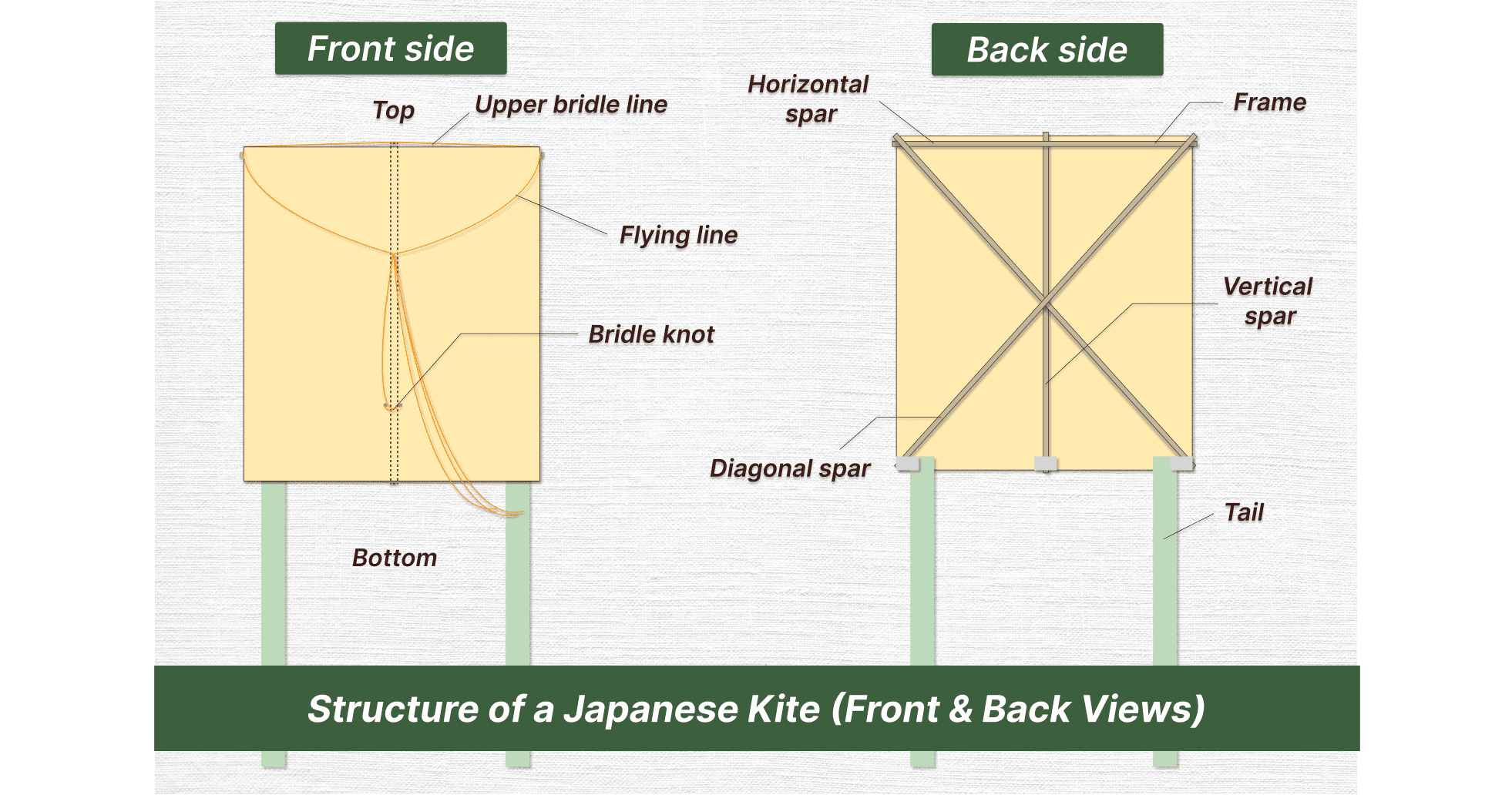
The main materials used in making wadako are:
- Frame: Bamboo — light, flexible, and surprisingly strong.
- Surface: Washi paper — smooth yet durable, perfect for detailed hand-painted designs.
- Tail (optional): Strips of paper, cloth, or thin bamboo pieces added to balance flight.
- Sound attachments: Some kites feature a bow-shaped unari, which produces a soft buzzing sound as the wind passes through.
Together, these elements create kites that are not only durable and stable in flight, but also beautiful works of traditional craftsmanship — alive with the gentle spirit of the wind.
Major Traditional Kite Types
Each region of Japan has developed its own unique kite shapes and designs, reflecting the creativity and character of the people who make and fly them.
Let’s take a look at some of the most iconic and culturally significant types of traditional Japanese kites.
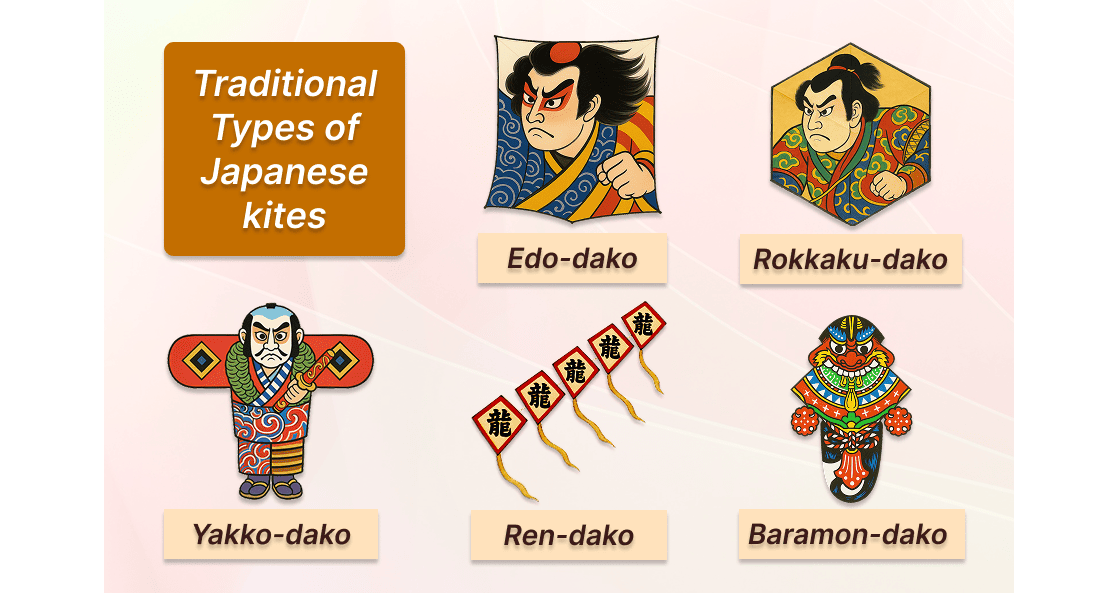
| Name | Shape / Style | Features and Cultural Notes |
|---|---|---|
| Edo-dako (江戸凧) | Rectangular | Originating in Edo (Tokyo), these kites feature bold, dynamic paintings of samurai, heroes, and kabuki actors. |
| Rokkaku-dako (六角凧) | Hexagonal | Known for stability in the air, often used in spirited kite battles. Common in the Chubu and Kansai regions. |
| Yakko-dako (奴凧) | Human figure with outstretched arms | Represents a loyal servant or footman — a symbol of strength and dedication. |
| Ren-dako (連凧) | Multiple connected rectangular kites | A spectacular chain of kites flown together, creating a wave of color across the sky during festivals. |
| Baramon-dako (バラモン凧) | Rounded with curved wings and decorative tails | Unique to the Goto Islands of Nagasaki. These powerful kites, painted with brave warriors, emit a loud buzzing sound that echoes over the sea breeze. |
No matter the type or region, traditional Japanese kites embody a deep sense of harmony with nature and the careful craftsmanship of the artisans who create them.
Each kite is a gentle work of art — filled with the spirit of connection, linking communities, generations, and hearts through the shared joy of watching them dance in the wind.
Three Most Famous Traditional Kite Festivals in Japan
Would you like to see Japan’s traditional kite flying in action?
Across Japan, kite festivals fill the skies each year with color, music, and excitement.
Each region has its own unique way of celebrating, but here are three of the most famous festivals where Japan’s kite culture truly comes to life.
1. Hamamatsu Festival (浜松まつり) – Shizuoka Prefecture
Every year from May 3–5, the coastal city of Hamamatsu comes alive with the roar of drums, cheering crowds, and kites soaring above the Nakatajima Sand Dunes.
With over 450 years of history, this is one of Japan’s most famous and energetic kite festivals.

- Highlights:
- Enormous kites, proudly painted with the names of newborn children, are launched to the skies as prayers for health and happiness.
- String battles (糸切り合戦, ito-kiri gassen) fill the air with tension and cheers as teams try to cut their opponents’ lines.
- As night falls, the celebration continues with float parades, glowing lanterns, and lively festival music.
Official Website (English): Hamamatsu Festival
2. Sagami Giant Kite Festival (相模の大凧まつり) – Kanagawa Prefecture
In early May, the wide banks of the Sagami River in Sagamihara City turn into the stage for one of Japan’s most astonishing sights — a single giant kite measuring up to 14.5 meters square and weighing nearly one ton taking flight.
- Highlights:
- Each team launches one enormous kite, carefully built by dozens of craftspeople using traditional techniques.
- The moment the kite catches the wind and lifts into the sky is both breathtaking and emotional — a celebration of teamwork and dedication.
- With a history of over 300 years, the festival continues to honor the Edo-period artisans who first created these sky giants.
Event Guide (English): Sagami Giant Kite Festival
Official Website (English): The Giant Kites of Sagami
3. Shirone Giant Kite Battle (白根大凧合戦) – Niigata Prefecture
In early June, along the banks of the Shinano River in Niigata’s Shirone district, a thrilling battle takes to the skies.
This is the Shirone Giant Kite Battle, a dramatic event that has electrified crowds for over 300 years.
- Highlights:
- Massive kites — some more than 7 meters wide — are launched from opposite riverbanks.
- As they rise, their lines tangle midair, and teams on both sides pull with all their strength in an intense tug-of-war.
- The sound of shouting, drums, and snapping strings fills the air, creating a festival of strength, skill, and unity.
Official Website (Japanese): Shirone Giant Kite Battle
Shirone Giant Kite Battle 2025 Special Site (Japanese): Shirone Giant Kite Battle Special Site
Each of these festivals is bursting with energy, excitement, and community spirit.
They capture the joy of people coming together, the skill of traditional craftsmanship, and the awe-inspiring moment when kites rise gracefully into the sky— a shared celebration carried by the wind.
Keeping the Tradition Alive
Beyond the grand kite festivals, there are many other ways to experience Japan’s rich kite culture.
Let’s explore some of the most meaningful ways to connect with Japan’s kite heritage beyond the festivals.
Kite Museums in Japan
One of the best ways to experience the beauty and variety of Japanese kites is by visiting a kite museum.
Here, visitors can explore history, craftsmanship, and regional diversity — all under one roof.
-
World Kite Museum: Higashiomi Giant Kite Museum (世界凧博物館 東近江大凧会館) – Shiga Prefecture
Dedicated to the tradition of the Higashiomi Giant Kite (東近江大凧), this museum exhibits both Japanese and international kites, showcasing how wind and imagination connect cultures. -
Ikazaki Kite Museum (五十崎凧博物館) – Ehime Prefecture
Located in the small, scenic town of Ikazaki, this museum celebrates the local kite-making heritage.
Visitors can enjoy hands-on workshops, historical exhibits, and colorful displays of Ikazaki kites, each filled with regional charm.
Other Preservation Efforts
Across Japan, countless individuals and communities are working to preserve the tradition of kite flying — keeping it alive through creativity and a strong sense of community spirit.

-
Workshops and Hands-on Experiences:
Festivals and cultural centers often host kite-making classes for children and adults alike, teaching how to build kites using bamboo and washi paper — just as artisans have done for generations. -
Cultural Preservation Groups:
Organizations like the Japan Kite Association (日本の凧の会) and local groups in Hamamatsu, Sagamihara, Shirone and Ikazaki promote kite culture through public demonstrations, educational programs, and international exchanges. -
Art Exhibitions and Tourism Events:
Museums and galleries across Japan hold special exhibitions celebrating kite art and history.
At international kite festivals, participants from around the world come together — united by the wind itself.
Today, Japanese kites are cherished not only as nostalgic toys, but as living cultural expressions — blending traditional craftsmanship with modern creativity, and carrying Japan’s timeless spirit high into the sky.
Conclusion: A Skyward Connection to Japanese Culture
From the elegant pastimes of Heian nobles to the grand festivals that color Japan’s modern skies, kites in Japan have always been more than simple toys.
They carry artistry, history, and heartfelt wishes, deeply rooted in the rhythm of Japanese life for centuries.
Each time a kite takes flight, it carries the hopes and dreams of those who craft and fly it — a living thread that connects tradition and creativity, past and present, people and sky.
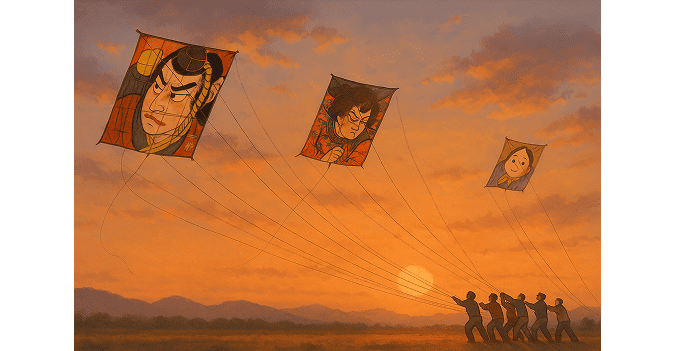
Whether watching a giant kite soaring high above a festival, crafting your own in a local workshop, or quietly gazing at one drifting through the park breeze, in that moment, you too are touching a part of Japan’s enduring cultural soul.
For in Japan, the sky is never just a backdrop.
It is a canvas of connection, celebration, and timeless spirit — a place where the wind still carries the dreams of generations.